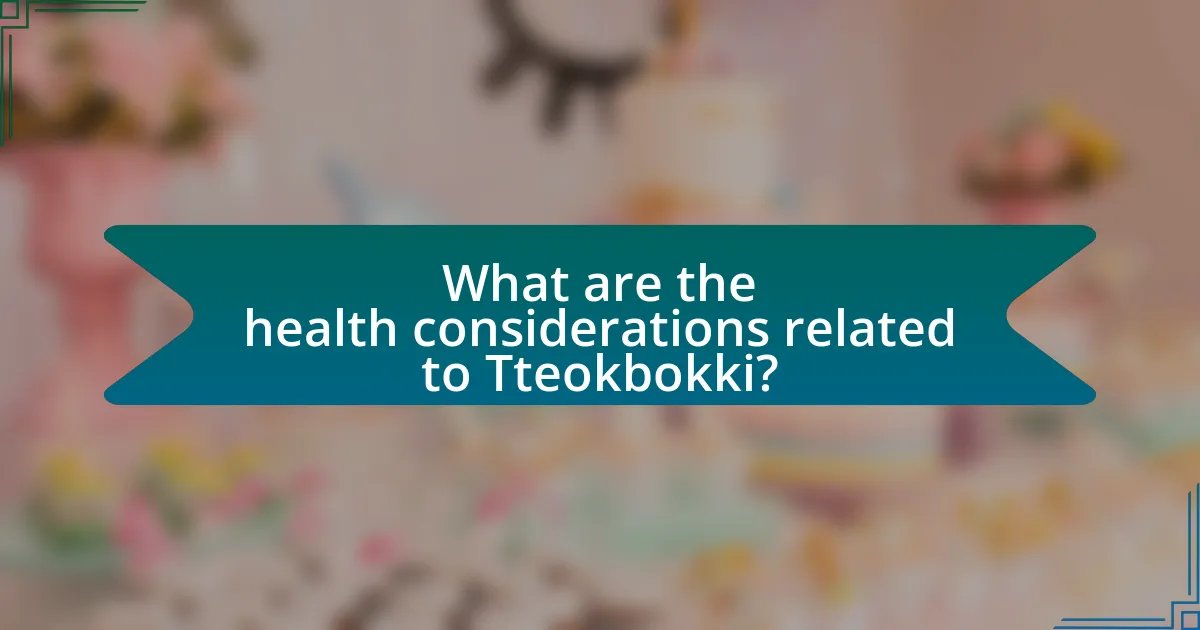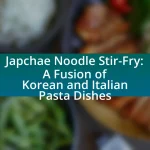Tteokbokki is a popular Korean dish made from chewy rice cakes stir-fried in a spicy and sweet sauce, primarily using gochujang. Originating from royal court cuisine, it has transformed into a beloved street food, often accompanied by fish cakes and vegetables. The article explores traditional preparation methods, essential ingredients, and various regional and modern variations of Tteokbokki. It also discusses its cultural significance in Korean street food, its representation in media, and the impact of globalization on its popularity. Additionally, health considerations and tips for enhancing the Tteokbokki experience are provided, making it a comprehensive overview of this iconic dish.

What is Tteokbokki?
Tteokbokki is a popular Korean dish made from chewy rice cakes, known as tteok, which are stir-fried in a spicy and sweet sauce typically made from gochujang (Korean red chili paste). This dish has its origins in the royal court cuisine of Korea and has evolved into a beloved street food, often served with fish cakes, vegetables, and boiled eggs. The combination of textures and flavors makes tteokbokki a unique culinary experience, contributing to its widespread popularity in both Korea and internationally.
How is Tteokbokki traditionally prepared?
Tteokbokki is traditionally prepared by first boiling cylindrical rice cakes in water until they soften. After softening, the rice cakes are stir-fried with gochujang (Korean chili paste), fish cakes, and vegetables such as scallions and cabbage. This dish is often simmered in a sweet and spicy sauce made from gochujang, sugar, and soy sauce, allowing the flavors to meld together. The preparation method has historical roots in Korean street food culture, where it has been enjoyed since the late 1950s, evolving into a popular snack across the country.
What ingredients are essential for making Tteokbokki?
The essential ingredients for making Tteokbokki are rice cakes, gochujang (Korean chili paste), fish cakes, and scallions. Rice cakes, known as “tteok,” serve as the primary component, providing the dish’s chewy texture. Gochujang adds the signature spicy and slightly sweet flavor, while fish cakes contribute additional protein and umami. Scallions are often included for freshness and garnish, enhancing the overall taste profile.
What cooking methods are commonly used for Tteokbokki?
Tteokbokki is commonly prepared using boiling and stir-frying methods. In the boiling method, the rice cakes are cooked in a spicy sauce made from gochujang (Korean chili paste) and other ingredients, allowing them to absorb the flavors. The stir-frying method involves cooking the rice cakes in a pan with the sauce and additional ingredients like fish cakes and vegetables, creating a thicker, more concentrated flavor. Both methods are traditional and widely used in Korean cuisine, showcasing the versatility of Tteokbokki.
What variations of Tteokbokki exist?
Tteokbokki has several variations, including the classic spicy version, cheese tteokbokki, and seafood tteokbokki. The classic version features chewy rice cakes in a gochujang (red chili paste) sauce, while cheese tteokbokki incorporates melted cheese for a creamy texture. Seafood tteokbokki adds ingredients like fish cakes and shrimp, enhancing the flavor profile. Other variations include curry tteokbokki, which uses curry powder for a different spice, and sweet tteokbokki, which incorporates sugar or sweet sauces for a milder taste. Each variation reflects regional preferences and ingredient availability, showcasing the versatility of this popular dish.
How do regional differences influence Tteokbokki recipes?
Regional differences significantly influence Tteokbokki recipes by altering the ingredients, flavors, and cooking methods used in various areas of South Korea. For instance, in Seoul, Tteokbokki is often prepared with a sweet and spicy sauce made from gochujang (red chili paste) and sugar, while in Busan, the dish may incorporate seafood, reflecting the coastal city’s access to fresh fish and shellfish. Additionally, regions like Jeolla Province emphasize the use of local vegetables and unique seasonings, resulting in variations that highlight local agricultural products. These regional adaptations not only showcase the diversity of Korean cuisine but also cater to local tastes and cultural preferences, making Tteokbokki a versatile dish that varies widely across the country.
What are some popular modern twists on traditional Tteokbokki?
Popular modern twists on traditional Tteokbokki include variations such as cheese Tteokbokki, which incorporates melted cheese for a creamy texture, and carbonara Tteokbokki, which combines the dish with a creamy pasta sauce. Other innovative adaptations feature seafood Tteokbokki, using ingredients like shrimp and squid, and vegan Tteokbokki, which substitutes traditional fish cakes with plant-based alternatives. These twists reflect a growing trend of fusion cuisine, appealing to diverse palates while maintaining the core elements of the original dish.

Why has Tteokbokki become a cultural phenomenon?
Tteokbokki has become a cultural phenomenon due to its unique blend of flavors, accessibility, and representation of Korean street food culture. This dish, made from chewy rice cakes and a spicy-sweet sauce, appeals to a wide audience, making it a popular choice among both locals and tourists. Its presence in various media, including K-dramas and social media platforms, has further amplified its popularity, showcasing it as a symbol of contemporary Korean cuisine. Additionally, the dish’s adaptability allows for numerous variations, catering to diverse tastes and preferences, which contributes to its widespread acceptance and cultural significance.
What role does Tteokbokki play in Korean street food culture?
Tteokbokki serves as a quintessential element of Korean street food culture, symbolizing both comfort and nostalgia for many Koreans. This dish, made from chewy rice cakes and often served in a spicy gochujang sauce, is widely available from street vendors across South Korea, particularly in bustling areas like Myeongdong and Dongdaemun. Its popularity is evidenced by the fact that it has been a staple since the late 1950s, evolving from a royal court dish to a beloved street food. Tteokbokki not only reflects the vibrant culinary landscape of Korea but also fosters social interaction, as it is commonly enjoyed in groups, making it a communal food experience.
How has Tteokbokki influenced social gatherings and events?
Tteokbokki has significantly influenced social gatherings and events by serving as a popular communal dish that fosters interaction and enjoyment among participants. This dish, made from chewy rice cakes and a spicy sauce, is often featured at street food stalls, festivals, and family gatherings, creating a shared culinary experience. The presence of Tteokbokki at these events encourages socialization, as people gather around food stalls or dining tables to enjoy it together, enhancing the overall atmosphere of camaraderie and celebration. Additionally, its popularity in South Korea has led to the establishment of Tteokbokki-themed events and competitions, further solidifying its role in social culture.
What impact has globalization had on Tteokbokki’s popularity?
Globalization has significantly increased Tteokbokki’s popularity worldwide. The rise of Korean pop culture, particularly through K-dramas and K-pop, has introduced Tteokbokki to international audiences, leading to its incorporation into global food trends. For instance, the proliferation of Korean restaurants and food trucks in cities around the world has made Tteokbokki more accessible, with a reported increase in demand for Korean cuisine in regions like North America and Europe. Additionally, social media platforms have facilitated the sharing of Tteokbokki recipes and experiences, further enhancing its visibility and appeal.
How is Tteokbokki represented in media and pop culture?
Tteokbokki is prominently represented in media and pop culture as a beloved street food in South Korea, often featured in television dramas, variety shows, and films. Its portrayal highlights the dish’s vibrant red color and spicy flavor, symbolizing comfort and nostalgia for many Koreans. For instance, popular dramas like “Goblin” and “My Love from the Star” showcase characters enjoying Tteokbokki, reinforcing its status as a cultural staple. Additionally, Tteokbokki has inspired various food-related content on social media platforms, where influencers share recipes and experiences, further embedding it in contemporary culture. This representation not only reflects its culinary significance but also its role in social gatherings and youth culture in South Korea.
What are some notable appearances of Tteokbokki in Korean dramas and films?
Tteokbokki has notable appearances in various Korean dramas and films, prominently featured in “Goblin,” where the character Eun Tak enjoys it as a comfort food, symbolizing warmth and nostalgia. In “Fight for My Way,” the dish is showcased during street food scenes, highlighting its cultural significance in everyday life. Additionally, “My Love from the Star” features Tteokbokki as a favorite snack of the lead character, emphasizing its popularity among younger generations. These instances illustrate Tteokbokki’s role as a beloved culinary staple in Korean pop culture.
How do social media trends affect Tteokbokki’s popularity?
Social media trends significantly enhance Tteokbokki’s popularity by amplifying its visibility and desirability among consumers. Platforms like Instagram and TikTok showcase visually appealing content, such as vibrant Tteokbokki dishes, which attract food enthusiasts and encourage sharing. For instance, viral challenges or food reviews can lead to increased foot traffic in restaurants serving Tteokbokki, as seen in the rise of Korean street food culture globally. Additionally, hashtags related to Tteokbokki often trend, creating a sense of community and driving engagement, which further solidifies its status as a popular dish.

What are the health considerations related to Tteokbokki?
Tteokbokki, a popular Korean street food made from rice cakes, has several health considerations. It is typically high in carbohydrates due to the rice cakes, which can lead to increased blood sugar levels if consumed in large quantities. Additionally, Tteokbokki is often prepared with spicy sauces that may cause digestive discomfort for some individuals, particularly those sensitive to spicy foods. The dish can also be high in sodium, especially when made with processed ingredients, which may contribute to hypertension if consumed excessively. Furthermore, variations that include fish cakes or other proteins can add to the calorie count, making portion control important for those monitoring their caloric intake.
How can Tteokbokki be made healthier?
Tteokbokki can be made healthier by substituting traditional ingredients with lower-calorie and nutrient-dense options. For instance, using whole grain rice cakes instead of regular rice cakes increases fiber content, while incorporating more vegetables, such as spinach, carrots, and bell peppers, enhances vitamins and minerals. Additionally, replacing sugary sauces with homemade versions that use less sugar or natural sweeteners can significantly reduce calorie intake. Studies show that increasing vegetable intake can improve overall diet quality and health outcomes.
What alternative ingredients can be used for a healthier version of Tteokbokki?
For a healthier version of Tteokbokki, alternative ingredients include whole grain rice cakes, low-sodium gochujang, and a variety of vegetables such as zucchini, carrots, and bell peppers. Whole grain rice cakes provide more fiber and nutrients compared to traditional white rice cakes. Low-sodium gochujang reduces the overall sodium content, making the dish heart-healthier. Incorporating vegetables not only enhances the nutritional profile but also adds flavor and texture, promoting a balanced meal. These substitutions align with dietary recommendations for increased whole grains and vegetables, supporting overall health.
How does portion control affect the healthiness of Tteokbokki?
Portion control significantly affects the healthiness of Tteokbokki by regulating calorie intake and nutrient balance. When consumed in moderation, Tteokbokki can be part of a balanced diet, as it typically contains carbohydrates from rice cakes, protein from fish cakes, and various vegetables. However, excessive portions can lead to high calorie consumption, contributing to weight gain and potential health issues such as obesity and diabetes. Studies indicate that controlling portion sizes can help manage overall dietary intake and promote healthier eating habits, thereby enhancing the nutritional profile of meals like Tteokbokki.
What are common misconceptions about Tteokbokki?
Common misconceptions about Tteokbokki include the belief that it is solely a street food and that it is always extremely spicy. While Tteokbokki is popular as a street food in South Korea, it is also enjoyed in homes and restaurants, often prepared with various ingredients and flavors. Additionally, not all Tteokbokki is spicy; there are versions made with sweet sauces or mild flavors, catering to different palates. This diversity in preparation and consumption highlights the versatility of Tteokbokki beyond the common spicy stereotype.
Is Tteokbokki suitable for all dietary restrictions?
Tteokbokki is not suitable for all dietary restrictions. Traditional tteokbokki is made from rice cakes, fish cakes, and a spicy sauce, which typically contains ingredients like gochujang (Korean chili paste) and sugar. This dish is not gluten-free due to the presence of wheat-based ingredients in the fish cakes and the potential for cross-contamination. Additionally, it may not be suitable for those with shellfish allergies, as some variations include seafood. Furthermore, tteokbokki is often high in carbohydrates and may not align with low-carb or ketogenic diets. Therefore, individuals with specific dietary restrictions should exercise caution when consuming tteokbokki.
What myths exist regarding the spiciness of Tteokbokki?
One prevalent myth regarding the spiciness of Tteokbokki is that all Tteokbokki is extremely spicy. In reality, the level of spiciness can vary significantly based on the recipe and the type of gochujang (Korean chili paste) used. Some variations are made with milder sauces or additional ingredients like cream or cheese, which can reduce the overall heat. Additionally, many people believe that Tteokbokki is only meant to be spicy, but it can also be prepared in non-spicy versions, catering to different taste preferences. This flexibility in preparation demonstrates that Tteokbokki can appeal to a wide range of palates, not just those who enjoy intense heat.
What tips can enhance the Tteokbokki experience?
To enhance the Tteokbokki experience, consider pairing it with a variety of side dishes such as fish cakes, boiled eggs, or pickled radish, which complement the dish’s flavors. Additionally, adjusting the spice level by adding more gochujang or gochugaru allows for a personalized taste. Serving Tteokbokki hot and fresh ensures the optimal texture and flavor, as the rice cakes are best enjoyed when they are chewy and warm. Finally, using a non-stick pan for cooking prevents sticking and allows for even heating, enhancing the overall enjoyment of the dish.
How can one choose the best Tteokbokki restaurant?
To choose the best Tteokbokki restaurant, one should prioritize establishments known for their authentic recipes and high-quality ingredients. Research indicates that restaurants using fresh rice cakes and homemade sauces tend to offer superior flavor and texture, which are essential for an authentic Tteokbokki experience. Additionally, customer reviews and ratings on platforms like Yelp or Google can provide insights into the restaurant’s consistency and service quality. Observing the restaurant’s popularity among locals can also be a strong indicator of its quality, as local patrons often favor places that excel in traditional dishes.
What are some recommended side dishes to pair with Tteokbokki?
Recommended side dishes to pair with Tteokbokki include Korean fried chicken, fish cakes, and kimchi. Korean fried chicken complements the spiciness of Tteokbokki with its crispy texture and savory flavor. Fish cakes, often served in a broth, provide a chewy contrast and enhance the overall meal experience. Kimchi adds a tangy and fermented taste that balances the richness of Tteokbokki, making it a traditional and popular accompaniment.


